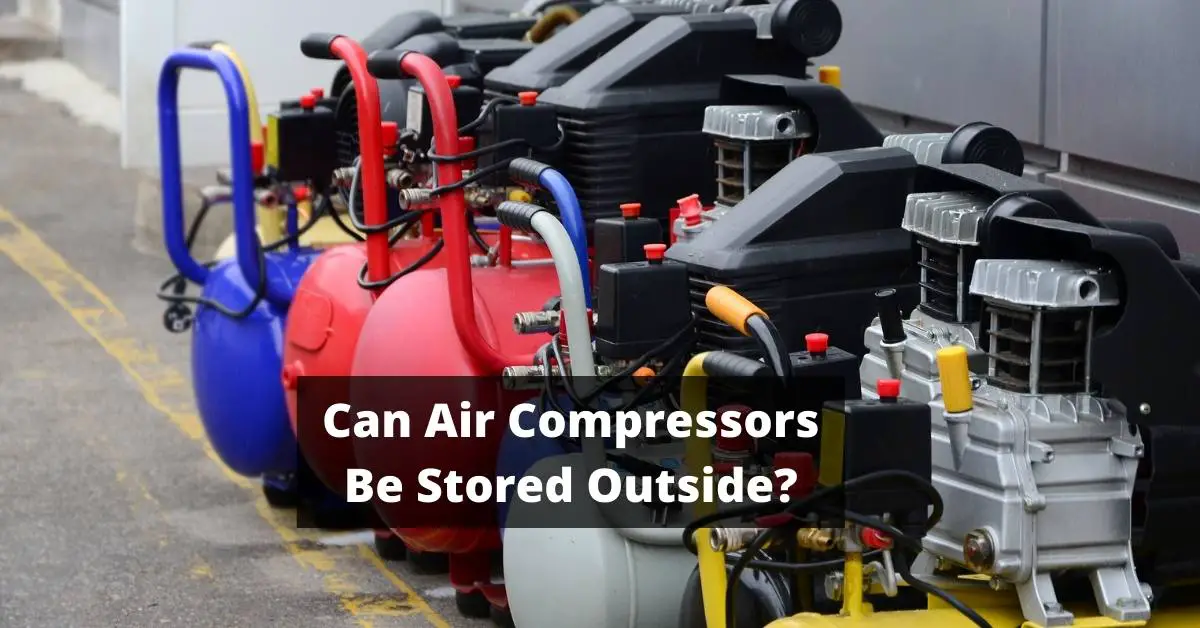Hey there! Are you tired of your air compressor tank accumulating rust and debris? As an experienced handyman, I know that a dirty air compressor tank can lead to decreased efficiency and even hazardous situations. That’s why it’s important to clean your air compressor tank regularly.
Cleaning an air compressor tank might seem like a daunting task, but with the right tools and knowledge, it’s actually quite simple. In this article, I’ll walk you through step-by-step on how to clean your air compressor tank effectively.
By the end of this article, you’ll have a cleaner and more efficient air compressor ready for any project. So let’s get started!
Turn off and Unplug the Compressor
You’ll want to make sure you shut down and unplug your machine, allowing it to cool off before proceeding with the next step. This is important as working on a hot compressor can be dangerous and may cause harm. Once you’ve switched off the power supply, give the machine enough time to cool down completely.
After shutting down and unplugging the compressor, take out any tools or accessories that are still attached to it. This ensures that everything is out of harm’s way during cleaning.
After this, open up the drain valve on the bottom of your air compressor tank. You’ll need a bucket or container to catch all the water and debris that will come out from inside your machine.
The first step in cleaning an air compressor tank is releasing pressure from it. To do this, make sure you follow all safety precautions such as wearing protective gear like gloves and goggles. With caution, use a release valve or pull ring to let out all pressure in your tank slowly.
Once done with this step, move on to removing grime using other methods such as vacuuming or wiping surfaces clean with a cloth.
Release Pressure from the Tank
Before moving on to the next step, make sure to fully release all pressure in the system – don’t risk injury or damage by skipping this crucial step. To do this, locate the pressure release valve on your air compressor tank and turn it counterclockwise until you hear a hissing sound. Keep turning until there is no more sound coming from the valve, indicating that all of the air has been released.
It’s important to note that even after releasing the pressure from your air compressor tank, there may still be some residual pressure left inside. To ensure that all of the pressure is released, try pulling on the safety relief valve located near the pressure switch. This will allow any remaining compressed air to escape and make it safe for you to move forward with cleaning your tank without risking injury.
Once all of the pressure has been released from your air compressor tank, it’s time to move onto removing the tank drain valve. This step is crucial for ensuring that any accumulated moisture or debris can be easily drained out of your tank before cleaning it thoroughly.
Remove the Tank Drain Valve
Removing the tank drain valve is a necessary step in preparing your system for maintenance, as it allows any excess moisture or debris to be easily drained from the tank. To start, locate the drain valve at the bottom of your air compressor tank and ensure that there’s no pressure left inside. Safety should always come first, so wear protective gloves and goggles before handling any part of the air compressor.
Next, use a wrench to turn counterclockwise on the drain valve until it’s completely removed. Be sure to catch any water or debris that may come out in a bucket or container. Once you’ve emptied everything inside, inspect the valve for damage or corrosion and clean it thoroughly before reinserting it back into place.
Remember that proper maintenance ensures optimal performance of your air compressor system. In order to achieve this, removing and cleaning your tank drain valve regularly can prevent potential issues down the line such as rust buildup or clogs.
Now that we’ve removed the tank drain valve, let’s move onto flushing out the tank with fresh water to ensure all remaining debris is eliminated from our system.
Flush Out the Tank
After draining the tank, it’s important to flush it out with fresh water to ensure that any remaining debris is completely eliminated and your compressor system runs smoothly. For example, imagine if you didn’t properly flush out your tank and a piece of debris got into your spray painting project, ruining hours of hard work. So, take some time to clean out the tank thoroughly.
To begin flushing out the tank, I recommend filling it up with fresh water until it reaches about halfway full. Then, close the drain valve and turn on the compressor to allow for pressurized water flow through the system. Let this run for about 10-15 minutes or until you see clear water coming out of the drain valve hose.
Once you’ve completed flushing out the debris from your air compressor tank, make sure to dry it off by opening all valves and allowing any remaining moisture to evaporate.
Afterward, continue onto reattaching the drain valve in order to complete maintenance on your air compressor system without any further issues arising down the line.
Reattach the Drain Valve
Let’s get ready to reattach that drain valve and ensure your compressor system is running at its best! Before you begin, make sure the threads on both the valve and tank are clean. If there’s any debris or rust, use a wire brush or sandpaper to remove it.
Apply some Teflon tape to the threads of the valve, making sure it wraps around in a clockwise direction. Next, gently screw in the drain valve by hand until it is snug against the tank. Use an adjustable wrench to give it one more turn, being careful not to overtighten. Overtightening can cause damage to either the valve or tank threads and result in leaks.
Once you have securely reattached the drain valve, check for any air leaks by turning on your compressor and allowing it to fill up with air. Listen for any hissing sounds or feel for any air blowing out near the drain valve. If everything seems secure and tight, move on to reassembling your compressor system so you can get back to work!
Reassemble the Compressor
Now that the compressor tank is clean and the drain valve has been reattached, it’s time to reassemble the compressor.
As someone who’s done this task several times, I know that replacing filters and oil is crucial in maintaining a well-functioning compressor.
Before powering up the compressor, it’s also important to check for any leaks in the system to ensure safety and efficiency.
Replace Filters and Oil
You’ll want to swap out those old filters and give your compressor a fresh dose of oil to keep it running like a well-oiled machine.
Over time, the filters in your air compressor tank can become clogged with debris and dust, which can cause your compressor to work harder than it needs to. This can lead to decreased efficiency and even damage over time. By replacing the filters regularly, you’ll ensure that your compressor is working at its best.
In addition to changing the filters, it’s important to add fresh oil to your compressor tank. Oil helps lubricate the moving parts of the compressor, reducing friction and wear on these components. Without proper lubrication, these parts can become damaged or worn down more quickly than they should be. By adding fresh oil regularly, you’ll help extend the life of your air compressor and keep it running smoothly for years to come.
Now that we’ve replaced our filters and added new oil, let’s move on to checking for leaks in our system.
Check for Leaks
It’s crucial to inspect your system for any leaks which may compromise its efficiency and result in potential damage over time. Checking for leaks is a simple process that can save you a lot of trouble down the line.
To do this, start by checking all the connections and fittings on your compressor tank, hoses, and air tools. Look for any signs of wear or damage such as cracks, rust, or corrosion. If you notice anything unusual or suspect a leak, tighten the connection or replace the damaged part immediately.
Another way to check for leaks is to use soapy water. Mix some dish soap with water in a spray bottle and apply it to all the connections while your compressor is running. If you see bubbles forming at any point along the system, there’s likely a leak that needs attention.
Once you’ve identified and fixed any leaks in your system, move on to testing your compressor to ensure everything is working properly without any further issues.
Test the Compressor
As I power up my metal beast, I feel the rumble of its inner workings and listen to the melody of compressed air flowing through its veins. Testing the compressor is an essential step in cleaning an air compressor tank. Before diving into cleaning, you need to ensure that your machine is functioning correctly.
To test your compressor, start by checking for any unusual sounds or vibrations. If there are any issues with the machine, it’s better to address them before proceeding with cleaning. You can also check if the pressure switch is working correctly by turning on the compressor and monitoring how quickly it reaches full pressure. If it takes longer than usual or doesn’t reach full pressure at all, then you may need to repair or replace certain parts.
Finally, testing your air compressor’s safety valve is crucial as well. The safety valve prevents excessive pressure build-up in the tank and protects against potential hazards such as explosions or fires. To test this valve, simply pull on the ring located at the top of it while your machine is running. If you hear a hissing sound or see air escaping from it immediately after pulling on it, then your safety valve is functioning correctly.
By following these steps and testing your machine properly before cleaning, you can ensure that everything runs smoothly during and after maintenance tasks are complete without risking injury or damage to your equipment.
Conclusion
In conclusion, cleaning an air compressor tank is essential to maintain its efficiency and lifespan. To ensure a successful cleaning process, it’s important to follow the proper steps carefully.
First, turn off and unplug the compressor before releasing pressure from the tank. Then, remove the tank drain valve and flush out the tank thoroughly.
After flushing out all debris and water from the tank, reattach the drain valve and reassemble the compressor. Finally, test your compressor to make sure everything is working properly before using it again.
By following these steps with attention to detail, you can help prolong your air compressor’s life expectancy and improve its performance for years to come.


